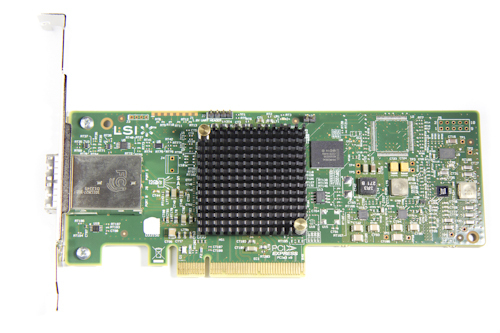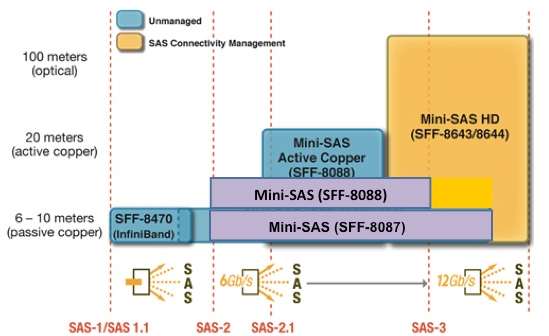LSI SAS 9300-8e & HGST Ultrastar SSD800MM: 12 Gb/s SAS, Tested
With the announcement of LSI's SAS 9300-8e and HGST's Ultrastar SSD800MM earlier this year, the world was officially introduced to 12 Gb/s SAS. Today we get our first look at how two times the interface bandwidth translates to real-world performance.
LSI SAS 9300-8e Specifications
If you're already familiar with LSI's HBA line-up, then you'll be right at home with the SAS 9300-8e. Looking down at the board, you immediately notice a large heat sink covering the Fusion-MPT-based LSI SAS 3008 I/O controller.
The SAS 3008 offers eight 12 Gb/s ports and interfaces with an eight-lane PCI Express 3.0 link. It's compatible with 3 and 6 Gb/s SATA connections, along with 3, 6, and 12 Gb/s SAS transfers. RAID 0, 1, and 10 are supported natively. Moreover, you can use expanders to attach as many as 1024 SAS or SATA end devices to the SAS 9300-8e. All of that is available in a low-profile form factor intended to live in a server environment.
Perhaps the most notable physical change is the card's four-lane mini-SAS HD external connectors, of which there are two. Of course, like roads in a major city, the powers that be cannot let there just be one name. The SAS 2.1 standard refers to it as mini-SAS HD, Molex uses iPass+ HD, and the SFF committee calls it SFF-8644. Whatever nomenclature you prefer, you get eight total ports of connectivity, totaling 96 Gb/s of throughput.
The new connector introduces a number of benefits. As you see in the chart above from the SCSI Trade Association, both SFF-8643 and SFF-8644 allow for optical cables that extend the maximum length to 100 m. This means direct-attached storage systems can be located in different rooms of a data center, or even different buildings. Those distances open up applications typically addressed by Ethernet and Fibre Channel, but at superior speeds.
Since the connector system is physically smaller than mini-SAS, density doubles. Now you can get 16 ports on a low-profile, half-length PCIe card. LSI's SAS 9300-8e does not take advantage of that potential space savings, but there's already another product on the market that does. You may have noticed a similar connector on Adaptec's 7-series RAID adapters. The company jumped the gun and introduced SFF-8643 (internal) connectors on its newest 6 Gb/s product. The company is able to get 16 ports onto a board that fits into the very smallest servers.
Expect the SAS 9300-8e to show up later this summer, though we don't yet know how much it'll cost.
Get Tom's Hardware's best news and in-depth reviews, straight to your inbox.
Current page: LSI SAS 9300-8e Specifications
Prev Page 12 Gb/ SAS: Welcoming The Next Generation Of Enterprise Storage Next Page HGST Ultrastar SSD800MM Specifications-
major-error The performance and relative maturity of this prototype drive certainly is impressive, but this is what the enterprise space demands.Reply
At the consumer level though, the article takes on a completely different tone--I would be very surprised if we don't start seeing mention of PCIe4 at/before the top of the next CPU cycle (so, in 24-36 months at most.) -
raidtarded Actually, Adaptec already saturated PCIe 3.0 with 6GB/s. The chart is incorrect, it doesn't take 12Gb/s to saturate the PCIe bus. Well, not for Adaptec.Reply -
falcompsx Remember when mechanical hard drives struggled to saturate their interfaces? Times sure have changed with SSD tech.Reply -
CaedenV Reply11006286 said:The performance and relative maturity of this prototype drive certainly is impressive, but this is what the enterprise space demands.
At the consumer level though, the article takes on a completely different tone--I would be very surprised if we don't start seeing mention of PCIe4 at/before the top of the next CPU cycle (so, in 24-36 months at most.)
Ya, my bet is that we will not start to see SATA4 or PCIe4 until Skymont at the earliest. Considering it is looking like Broadwell may be pushed back due to 14nm die shrink issues I would bet that Skymont will have similar issues when moving to 10nm. But at least for home users you can cram 2 SSDs in RAID0 with a proper RAID card and get a little performance boost until then. I guess the only problem is that most people are going to use the onboard Intel RAID for RAID0, which will get you a killer synthetic benchmark, but in practical reality it is really just expanding your volume with very little speed benefit. -
bit_user * wipes drool off floor *Reply
That's a quality review of some quality products. I like the insights shared, throughout. I especially appreciated the link to the SATA-Express paper. Thanks!
MORE REVIEWS LIKE THIS!!
:) -
bit_user Reply
How many ports and how many lanes, though? If it's just a 8-port card, the math doesn't support that, as 6x8 = 48 Gbps, which is less than the 8 x 8 = 64 Gbps that a x8 PCIe 3.0 slot should carry.11006482 said:Actually, Adaptec already saturated PCIe 3.0 with 6GB/s. The chart is incorrect, it doesn't take 12Gb/s to saturate the PCIe bus. Well, not for Adaptec.
-
raidtarded It is the equivalent of a nuke bomb compared to the LSI products. It has 24 Native ports.Reply11011736 said:
How many ports and how many lanes, though? If it's just a 8-port card, the math doesn't support that, as 6x8 = 48 Gbps, which is less than the 8 x 8 = 64 Gbps that a x8 PCIe 3.0 slot should carry.11006482 said:Actually, Adaptec already saturated PCIe 3.0 with 6GB/s. The chart is incorrect, it doesn't take 12Gb/s to saturate the PCIe bus. Well, not for Adaptec.


